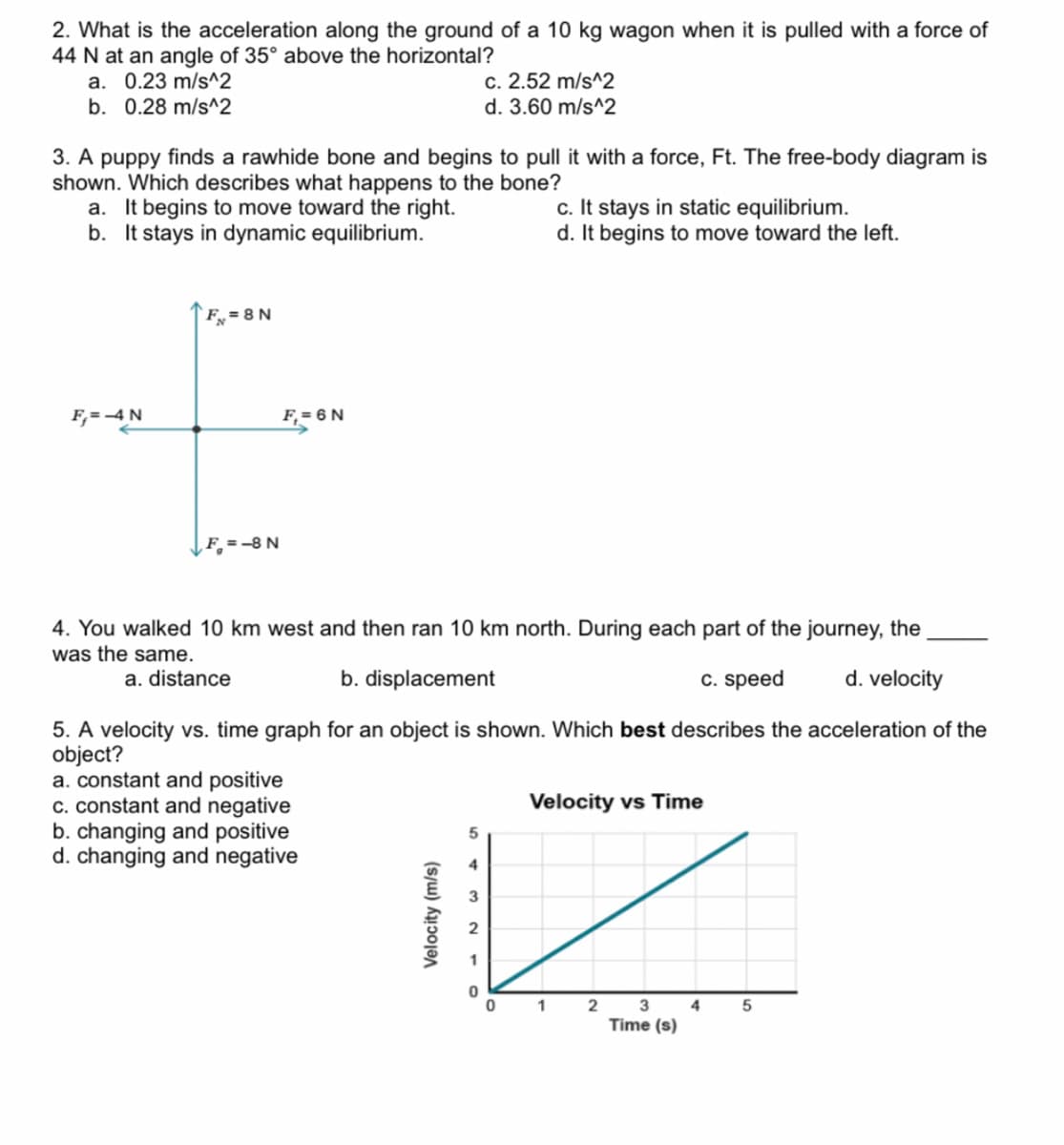2. What is the acceleration along the ground of a 10 kg wagon when it is pulled with a force of 44 N at an angle of 35° above the horizontal? a. 0.23 m/s^2 b. 0.28 m/s^2 c. 2.52 m/s^2 d. 3.60 m/s^2
2. What is the acceleration along the ground of a 10 kg wagon when it is pulled with a force of 44 N at an angle of 35° above the horizontal? a. 0.23 m/s^2 b. 0.28 m/s^2 c. 2.52 m/s^2 d. 3.60 m/s^2
College Physics
1st Edition
ISBN:9781938168000
Author:Paul Peter Urone, Roger Hinrichs
Publisher:Paul Peter Urone, Roger Hinrichs
Chapter4: Dynamics: Force And Newton's Laws Of Motion
Section: Chapter Questions
Problem 16PE: A brave but inadequate rugby player is being pushed backward by an opposing player who is exerting a...
Related questions
Question

Transcribed Image Text:2. What is the acceleration along the ground of a 10 kg wagon when it is pulled with a force of
44 N at an angle of 35° above the horizontal?
a. 0.23 m/s^2
b. 0.28 m/s^2
c. 2.52 m/s^2
d. 3.60 m/s^2
3. A puppy finds a rawhide bone and begins to pull it with a force, Ft. The free-body diagram is
shown. Which describes what happens to the bone?
a. It begins to move toward the right.
b. It stays in dynamic equilibrium.
c. It stays in static equilibrium.
d. It begins to move toward the left.
`Fx = 8 N
F,= -4 N
F, = 6 N
F =-8 N
4. You walked 10 km west and then ran 10 km north. During each part of the journey, the
was the same.
a. distance
b. displacement
c. speed
d. velocity
5. A velocity vs. time graph for an object is shown. Which best describes the acceleration of the
object?
a. constant and positive
C. constant and negative
b. changing and positive
d. changing and negative
Velocity vs Time
4
2
1
2
3
4
Time (s)
Velocity (m/s)
Expert Solution
This question has been solved!
Explore an expertly crafted, step-by-step solution for a thorough understanding of key concepts.
This is a popular solution!
Trending now
This is a popular solution!
Step by step
Solved in 2 steps with 1 images

Knowledge Booster
Learn more about
Need a deep-dive on the concept behind this application? Look no further. Learn more about this topic, physics and related others by exploring similar questions and additional content below.Recommended textbooks for you

College Physics
Physics
ISBN:
9781938168000
Author:
Paul Peter Urone, Roger Hinrichs
Publisher:
OpenStax College


Physics for Scientists and Engineers, Technology …
Physics
ISBN:
9781305116399
Author:
Raymond A. Serway, John W. Jewett
Publisher:
Cengage Learning

College Physics
Physics
ISBN:
9781938168000
Author:
Paul Peter Urone, Roger Hinrichs
Publisher:
OpenStax College


Physics for Scientists and Engineers, Technology …
Physics
ISBN:
9781305116399
Author:
Raymond A. Serway, John W. Jewett
Publisher:
Cengage Learning

Glencoe Physics: Principles and Problems, Student…
Physics
ISBN:
9780078807213
Author:
Paul W. Zitzewitz
Publisher:
Glencoe/McGraw-Hill

College Physics
Physics
ISBN:
9781285737027
Author:
Raymond A. Serway, Chris Vuille
Publisher:
Cengage Learning

College Physics
Physics
ISBN:
9781305952300
Author:
Raymond A. Serway, Chris Vuille
Publisher:
Cengage Learning
Expert Answers to Latest Homework Questions
Q: a.
What multiple of a = [1]
should be subtracted from b =
to make the result
B orthogonal to a?…
Q: Find two orthogonal vectors in the plane x + y +2z = 0:
S1
Make them orthonormal:
q1
and S2:
and
92=
Q: Let
=
A
[2.5]
and y
=
5
0.5
Use the Gram-Schmidt process to determine an orthonormal basis for the…
Q: Let
f(x)=-4, g(x) = -5x+7 and h(x) = -2x²-9x + 9.
Consider the inner product
(p,q) = p(-1)q(−1) +…
Q: Let
0
-
.9
3
-3
.4
, Y
2
8
14
Use the Gram-Schmidt process to determine an orthonormal basis for the…
Q: Let
2
and y
-2
6
0
8
Use the Gram-Schmidt process to determine an orthonormal basis for the subspace…
Q: Perform the Gram-Schmidt process on the following sequence of vectors.
6
=
=
3
1
9.
Q: Find the dot product of
TH
x =
and y =
3
Q: Find the dot product of
x = 5
and y =
0
x.ÿ=
2
ི ༠༠
Q: Find the angle a in radians between the vectors
απ
-3]
and
Q: Let {ē1, ē2, ē3, ĕ4, 5, 6} be the standard basis in R6. Find the length of the vector
x=-4e1 +3e24e3…
Q: Find the length of the vector =
[4].
Q: Find the angle a between the vectors
απ
-4
4
and
1
6
Q: =
Suppose (3, −1, −2), = (-1, 1, −4) and w =
.
9.
9.
v.w=
9.
v. v=
ū⋅ (v+w)=
.
9.
(5, 1, 1). Then:
Q: Find the length of the vector =
6
Q: Find the angle a, in radians, between the vectors
a =
α
3
-4 and
5
1
Q: If ||v|| = 2 and ||w|| = 1:
What is the smallest possible value of ||vw||?
What is the largest…
Q: Find nonzero vectors v and w that are perpendicular to (1,0, 1) and to each other.
v:
w:
9.
Q: 1. Specialization and trade
A country may specialize in the production of a good that it can produce…
Q: With v =
(2, 1) and w= (2,3), choose a number c so that w- cv is perpendicular to
v.
C:
What is the…
Q: (a) What equation describes every vector w = (w1, w2) that is perpendicular to
v = (-1,-2)?
ալ +
աշ…